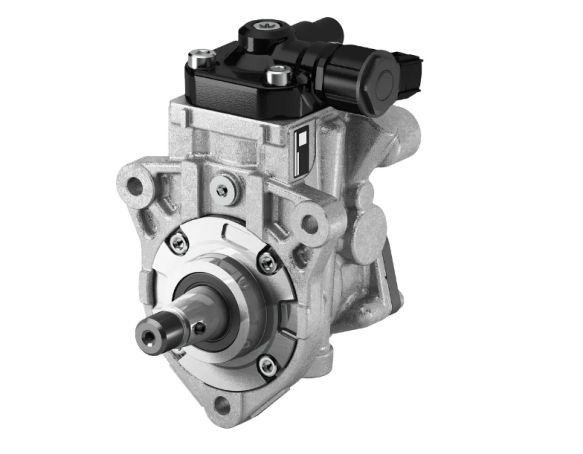
DENSO is a world leader in diesel technology and in 1991 was the first original equipment (OE) manufacturer of ceramic glow plugs and pioneered the common rail system (CRS) in 1995. This expertise continues to allow the company to help vehicle manufacturers around the world to create increasingly responsive, efficient and reliable vehicles.
One of the key characteristics of the CRS, which has played a large part in delivering the efficiency gains associated with it, is the fact that it operates with the fuel under pressure. As the technology has evolved and engine performance improved, so has the pressure of the fuel in the system increased, from 120 megapascals (MPa) or 1,200 bar at the introduction of the first generation system, to 250 MPa for a current fourth generation system. To demonstrate the dramatic impact that this generational development has yielded, comparative fuel consumption is down by 50%, emissions down by 90% and engine power up by 120%, during the 18 years between a first and fourth generation CRS.
High Pressure Fuel Pumps
In order to operate successfully at such high pressures, the CRS relies on three vital elements: the fuel pump, injectors and electronics, and naturally these have all developed with each generation. So, the original HP2 fuel pumps used primarily for the passenger car segment in the late 1990s, have gone through several incarnations to become the HP5 versions used today, 20 years later. Largely driven by the capacity of the engine, they are available in single (HP5S) or dual cylinder (HP5D) variants, with their discharge quantity controlled by a pre-stroke control valve, which ensures the pump maintains its optimum pressure, whether or not the engine is under load. Alongside the HP5 pump used for passenger cars and smaller capacity commercial vehicles, is the HP6 for six to eight-litre engines and the HP7 for capacities above that.
Fuel Injectors
Although, throughout the generations, the function of the fuel injector has not changed, the complexity of the fuel delivery process has developed significantly, particularly when it comes to the spread pattern and dispersion of the fuel droplets in the chamber, to maximise combustion efficiency. However, it’s how they are controlled that continues to undergo the greatest change.
As worldwide emissions standards became increasingly stringent, purely mechanical injectors gave way to solenoid controlled electromagnetic versions, working with sophisticated electronics to improve their performance and therefore reduce emissions. However, just as the CRS has continued to evolve, so has the injector, as to achieve the latest emission standards, their control has had to become ever more precise and the need to respond in microseconds become imperative. This has led to Piezo injectors entering the fray.
Rather than relying on electromagnetic dynamics, these injectors contain piezo crystals, which, when exposed to an electrical current, expand, only returning to their original size as they discharge. This expansion and contraction takes place in microseconds and the process forces fuel from the injector into the chamber. Due to the fact that they can act so fast, Piezo injectors can carry out more injections per cylinder stroke then a solenoid activated version, under higher fuel pressure, which improves combustion efficiency still further.
Electronics
The final element is the electronic management of the injection process, which alongside the analysis of many other parameters, is traditionally measured with the use of a pressure sensor to indicate pressure in the fuel rail feed to the engine control unit (ECU). However, despite developing technology, fuel pressure sensors can still fail, causing error codes and, in extreme cases, complete ignition shutdown. As a result, DENSO pioneered a more accurate alternative that measures the pressure in the fuel injection system through a sensor embedded in each injector.
Based around a closed-loop control system, DENSO’s Intelligent–Accuracy Refinement Technology (i-ART) is a self-learning injector fitted with its own microprocessor, enabling it to autonomously adjust the fuel injection quantity and timing to their optimal levels and communicating this information to the ECU. This makes it possible to continuously monitor and adapt fuel injection per combustion in each of the cylinders and means that it also self-compensates over its service life. i-ART is a development that DENSO has not only incorporated into its fourth generation Piezo injectors, but also selected solenoid activated versions of the same generation.
The combination of higher injection pressure and i-ART technology is a breakthrough that helps maximise engine performance and reduce energy consumption, yielding a more sustainable environment and driving the next stage of diesel evolution.
The Aftermarket
One of the major implications for the European independent aftermarket is that, although repair tools and techniques are under development for the DENSO authorised repair network, at present there is not a practical repair option for fourth generation fuel pumps or injectors.
Therefore, although fourth generation CRS service and repair can, and should be, undertaken by the independent sector, fuel pumps or injectors that have failed cannot currently be repaired, so must be replaced with new parts of matching OE quality supplied by reputable manufacturers, such as DENSO.
Post time: Dec-08-2022
